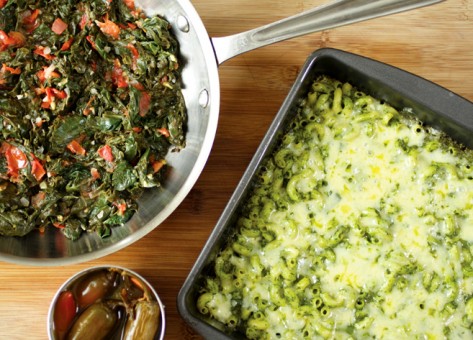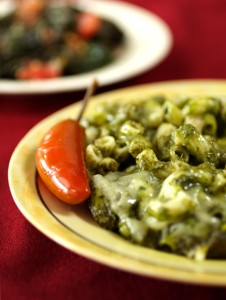Chard Done Mexican Style

Any fool can grow Swiss chard, I like to say. My gardening strategy is a process of elimination. I’ll give something one or two tries, and after that it’s off the list; I’ll let someone else, with greener thumbs than me, grow it. My goal is a garden of foolproof foods, and chief among them, come rain or shine, is Swiss chard. (Other foolproof greens are collards, kale, and mustard greens; but not spinach or watercress.)
Long before I started growing greens, I’d experimented cooking them in all sorts of different ways. Eventually I settled on a simple method that entails simmering frying whole or half cloves of garlic, depending on their size, in an ample quantity of olive oil in a skillet. (I tilt the skillet up so that the cloves are submerged in oil.) Once the cloves are a light golden brown and are aromatic, I add the cleaned and prepared greens, and, while tossing them to coat in the oil, sprinkle salt to season. I then add a small amount of water and cover to let the greens braise.
While I always enjoy greens done this way, it’s good to shake things up every so often. So I was happy to find several recipes in The Art of Mexican Cooking by Diana Kennedy, the current DCCC pick, which feature Swiss chard. I chose two recipes that showcase the green, but to very different effects: Stewed Swiss Chard (Acelgas Guisadas), which is a spicy elaboration on my tried-and-true braising method, and Macaroni with Swiss Chard (Sopa de Macarrón Y Acelgas), a decided departure from the braising technique with a rich, creamy taste reminiscent of creamed spinach.
The Stewed Swiss Chard requires only a bit more prep work than my dead simple braising method. Before adding the greens to the pan, garlic, onion, and Serrano chiles are briefly fried in oil, then chopped fresh tomatoes are added and cooked down slightly over moderately high heat. The greens, some liquid, and salt are added; the whole lot is covered and cooked until the greens are tender. (If you’re using frozen Swiss chard [see my note below], salt the tomato and onion mixture just before adding the greens for an even distribution of salt.) The tomatoes provide a touch of acid, a common pairing with greens, and a touch of sweetness, a nice counterpoint to the spicy chile heat. Diana Kennedy recommends serving this dish as a side course or as filling for enchiladas.
 In Macaroni with Swiss Chard, the green is transformed into an unctuous sauce, enriched with crème fraîche. First, macaroni is cooked in boiling salted water with chopped scallion and Mexican oregano. The chard is cooked with garlic and onion that’s been fried until just translucent and with some of the macaroni cooking water. Using a blender, an indispensible tool in the Mexican kitchen, the cooked chard is pureed with crème fraîche until smooth. The drained macaroni and puree are tossed together and baked until bubbling. Grated cheese is sprinkled over top and baked until melted. Did you notice that there is not a single chile, fresh or dried, used in this dish? In this case, chile heat is introduced as an optional condiment. Diana Kennedy suggests serving this rich dish as is or with chipotles en adobo or pickled jalapeños. I opted for the latter; the vinegar cuts the richness of the creamy sauce, which in turn cools the fiery heat of the pickle. It’s one of those ping pong pairings; going from one to the other, you could go on eating endlessly.
In Macaroni with Swiss Chard, the green is transformed into an unctuous sauce, enriched with crème fraîche. First, macaroni is cooked in boiling salted water with chopped scallion and Mexican oregano. The chard is cooked with garlic and onion that’s been fried until just translucent and with some of the macaroni cooking water. Using a blender, an indispensible tool in the Mexican kitchen, the cooked chard is pureed with crème fraîche until smooth. The drained macaroni and puree are tossed together and baked until bubbling. Grated cheese is sprinkled over top and baked until melted. Did you notice that there is not a single chile, fresh or dried, used in this dish? In this case, chile heat is introduced as an optional condiment. Diana Kennedy suggests serving this rich dish as is or with chipotles en adobo or pickled jalapeños. I opted for the latter; the vinegar cuts the richness of the creamy sauce, which in turn cools the fiery heat of the pickle. It’s one of those ping pong pairings; going from one to the other, you could go on eating endlessly.
Note: If you wish to make these recipes using your stash of blanched and frozen Swiss chard leftover from last summer’s harvest, which is what I did, it’s necessary to convert the quantity of greens from raw Swiss chard, given in pounds, to frozen Swiss chard. For the Stewed Swiss Chard, which calls for 1 pound Swiss chard, use 1¾ packed cups (10 ounces) frozen; for the Macaroni with Swiss Chard, which calls for ½ pound Swiss chard, use 1 packed cup (5 ounces) frozen. Because the greens are already blanched, it’s also necessary to reduce the cooking time and the amount of water used to cook the greens.

Sopa de macarron y acelgas is a recipe I have made at least a dozen times in the last few years, in part because a neighbor down the block grows a whole back yard full of Swiss chard every winter. In this household the recipe is greeted with delighted shrieks of “sopa seca!”
I used to put in much more crema mexicana than DK calls for. I did it out of love. Lately I have tried it as she prescribes and found that the extra crema mexicana isn’t necessary, and the whole concoction tastes more like chard without it.
Also, if I have time, I ignore DK’s admonition to set aside the chard stems. Rather, I chop them up fine and cook them first before putting in the onion and garlic and chard leaves.
When I scoop the chard concoction out of the frying pan and into the blender, if there is some chopped up onion and chard stem left in the pan, I mix it back into the recipe before putting it in the baking dish. Some folks in my household like to find the bonus bits of onion and other ingredients in the mix, rather than having an experience of the sauce as unrelievedly smooth.
I enjoyed seeing your image of the recipe made with macaroni. I have actually always made it with straight-up long spaghetti, broken in half. Throwing the oregano into the spaghetti pot makes the water turn a not altogether agreeable shade of brown. Don’t be alarmed. It’s still tasty.
One concession to USA tastes: I tend to add much more cheese on top than DK calls for, especially if I am using queso fresco rather than cheddar or queso Chihuahua, and folks in my household will complain if the top is not browned. So there you have it.
Also I like the acelgas done with what’s essentially pico de gallo as you described here per DK. If there’s really a pinch for time, you could pop open a can of pico de gallo (Herdez brand is OK) and fry it up with the chard in a jiffy. No slicing, no dicing.
1Thanks for sharing your experience with sopa de macarron y acelgas. What a fantastic and helpful comment. You’re lucky to have a plentiful source of fresh picked chard, and I like your idea of chopping up the chard stem and using it in the dish. It’s nice not to waste any part of edible food. And you’re right about the oregano in the cooking water. Sometimes things that may not look picture perfect taste really great. Thanks for your tips about using premade pico de gallo, too. Have you tried making homemade queso fresco? I’ve got a recipe for it on the blog. It was so very delicous. I realize that most people will simply buy it, but I couldn’t find any close by where I live in rural Vermont. Sometimes scarcity is a good incentive for creativity!
2After Heart surgery my husband had a visiting nurse from Mexico. She shared this recipe with me. It is great
3Donna, how nice that you’ve had a personal experience with this recipe, rather than just from a book, like me (albeit a great book . . .). Thanks for sharing your connection with this dish. Your story should entice people to make it all the more, knowing it’s as healthy as it is flavorful.
4